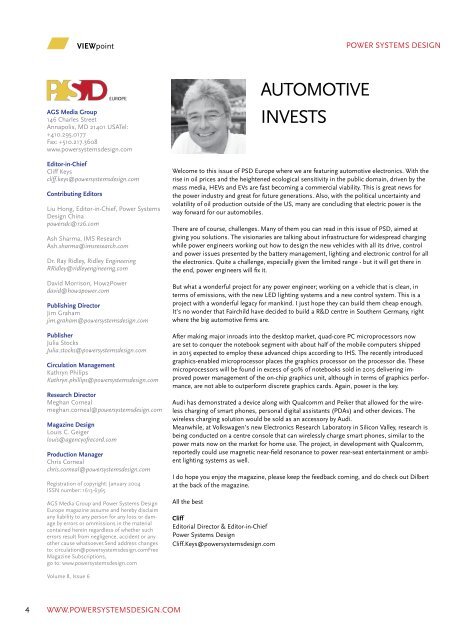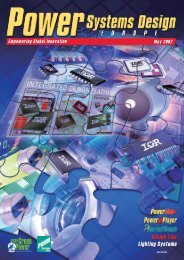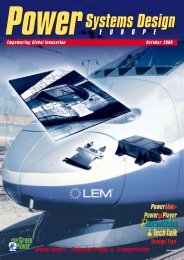Testing Virtual ECUs - Power Systems Design
Testing Virtual ECUs - Power Systems Design
Testing Virtual ECUs - Power Systems Design
Create successful ePaper yourself
Turn your PDF publications into a flip-book with our unique Google optimized e-Paper software.
4<br />
VIEWpoint<br />
AGS Media Group<br />
146 Charles Street<br />
Annapolis, MD 21401 USATel:<br />
+410.295.0177<br />
Fax: +510.217.3608<br />
www.powersystemsdesign.com<br />
Editor-in-Chief<br />
Cliff Keys<br />
cliff.keys@powersystemsdesign.com<br />
Contributing Editors<br />
Liu Hong, Editor-in-Chief, <strong>Power</strong> <strong>Systems</strong><br />
<strong>Design</strong> China<br />
powersdc@126.com<br />
Ash Sharma, IMS Research<br />
Ash.sharma@imsresearch.com<br />
Dr. Ray Ridley, Ridley Engineering<br />
RRidley@ridleyengineerng.com<br />
David Morrison, How2<strong>Power</strong><br />
david@how2power.com<br />
Publishing Director<br />
Jim Graham<br />
jim.graham@powersystemsdesign.com<br />
Publisher<br />
Julia Stocks<br />
Julia.stocks@powersystemsdesign.com<br />
Circulation Management<br />
Kathryn Philips<br />
Kathryn.phillips@powersystemsdesign.com<br />
Research Director<br />
Meghan Corneal<br />
meghan.corneal@powersystemsdesign.com<br />
Magazine <strong>Design</strong><br />
Louis C. Geiger<br />
louis@agencyofrecord.com<br />
Production Manager<br />
Chris Corneal<br />
chris.corneal@powersystemsdesign.com<br />
Registration of copyright: January 2004<br />
ISSN number: 1613-6365<br />
AGS Media Group and <strong>Power</strong> <strong>Systems</strong> <strong>Design</strong><br />
Europe magazine assume and hereby disclaim<br />
any liability to any person for any loss or damage<br />
by errors or ommissions in the material<br />
contained herein regardless of whether such<br />
errors result from negligence, accident or any<br />
other cause whatsoever.Send address changes<br />
to: circulation@powersystemsdesign.comFree<br />
Magazine Subscriptions,<br />
go to: www.powersystemsdesign.com<br />
Volume 8, Issue 6<br />
WWW.POWERSYSTEMSDESIGN.COM<br />
POWER SYSTEMS DESIGN<br />
Welcome to this issue of PSD Europe where we are featuring automotive electronics. With the<br />
rise in oil prices and the heightened ecological sensitivity in the public domain, driven by the<br />
mass media, HEVs and EVs are fast becoming a commercial viability. This is great news for<br />
the power industry and great for future generations. Also, with the political uncertainty and<br />
volatility of oil production outside of the US, many are concluding that electric power is the<br />
way forward for our automobiles.<br />
There are of course, challenges. Many of them you can read in this issue of PSD, aimed at<br />
giving you solutions. The visionaries are talking about infrastructure for widespread charging<br />
while power engineers working out how to design the new vehicles with all its drive, control<br />
and power issues presented by the battery management, lighting and electronic control for all<br />
the electronics. Quite a challenge, especially given the limited range - but it will get there in<br />
the end, power engineers will fix it.<br />
But what a wonderful project for any power engineer; working on a vehicle that is clean, in<br />
terms of emissions, with the new LED lighting systems and a new control system. This is a<br />
project with a wonderful legacy for mankind. I just hope they can build them cheap enough.<br />
It’s no wonder that Fairchild have decided to build a R&D centre in Southern Germany, right<br />
where the big automotive firms are.<br />
After making major inroads into the desktop market, quad-core PC microprocessors now<br />
are set to conquer the notebook segment with about half of the mobile computers shipped<br />
in 2015 expected to employ these advanced chips according to IHS. The recently introduced<br />
graphics-enabled microprocessor places the graphics processor on the processor die. These<br />
microprocessors will be found in excess of 90% of notebooks sold in 2015 delivering improved<br />
power management of the on-chip graphics unit, although in terms of graphics performance,<br />
are not able to outperform discrete graphics cards. Again, power is the key.<br />
Audi has demonstrated a device along with Qualcomm and Peiker that allowed for the wireless<br />
charging of smart phones, personal digital assistants (PDAs) and other devices. The<br />
wireless charging solution would be sold as an accessory by Audi.<br />
Meanwhile, at Volkswagen’s new Electronics Research Laboratory in Silicon Valley, research is<br />
being conducted on a centre console that can wirelessly charge smart phones, similar to the<br />
power mats now on the market for home use. The project, in development with Qualcomm,<br />
reportedly could use magnetic near-field resonance to power rear-seat entertainment or ambient<br />
lighting systems as well.<br />
I do hope you enjoy the magazine, please keep the feedback coming, and do check out Dilbert<br />
at the back of the magazine.<br />
All the best<br />
Cliff<br />
Editorial Director & Editor-in-Chief<br />
<strong>Power</strong> <strong>Systems</strong> <strong>Design</strong><br />
Cliff.Keys@powersystemsdesign.com<br />
AUTOMOTIVE<br />
INVESTS<br />
POWERline<br />
POWER SYSTEMS DESIGN JULY/AUGUST 2011<br />
DESIGN TOOLS FOR EV/HEV<br />
Simulation and test expert firm,<br />
dSPACE, is in the business of<br />
developing tools for the design of<br />
electronic control units (<strong>ECUs</strong>) and<br />
mechatronic systems.<br />
<strong>Testing</strong> <strong>Virtual</strong> <strong>ECUs</strong><br />
The virtual ECU, or<br />
V-ECU, comprises<br />
components from the<br />
application and the basic software,<br />
and provides functionalities<br />
comparable to those of a real<br />
ECU. Unlike a soft ECU, which<br />
uses only a simplified Simulink®/<br />
Stateflow® model, a V-ECU<br />
usually has the same software<br />
components that will run on<br />
the finished ECU. There is no<br />
strict dividing line between a soft<br />
ECU and a V-ECU, but a V-ECU<br />
generally represents the real ECU<br />
more realistically.<br />
Customers can use virtual ECU<br />
models for testing and validation<br />
throughout the ECU development<br />
process. The term 'virtual ECU<br />
testing' covers all simulation<br />
scenarios in which virtual <strong>ECUs</strong><br />
are used.<br />
Today's ECU software comprises<br />
numerous software components<br />
(SWCs) with intensive interactions.<br />
In the large ECU networks<br />
frequently installed in current<br />
vehicles, the number of SWCs can<br />
easily reach the thousands, and<br />
because the task of developing<br />
ECU components is usually shared<br />
by several departments or even<br />
different companies, not only<br />
the SWCs themselves have to be<br />
tested and validated, but also the<br />
interactions between them.<br />
Early <strong>Testing</strong> Without Hardware<br />
Previously, the testing and<br />
validation of ECU software could<br />
not even begin until the prototype<br />
<strong>ECUs</strong> were available. With virtual<br />
ECU testing (VET), the SWCs,<br />
which are already available, are<br />
combined to create a virtual ECU<br />
model. This is then tested and<br />
validated in offline simulation<br />
on a standard PC. This lets<br />
developers investigate real-world<br />
issues such as task scheduling,<br />
the behavior of the basic software,<br />
and communication behavior on a<br />
virtual CAN bus<br />
Simulating EV/ HEV Drives<br />
The dSPACE ASM Electric<br />
Components simulation package<br />
is now supported by JMAG, a<br />
Finite Element Analysis (FEA)<br />
tool for electromechanical<br />
design developed by the JSOL<br />
Corporation. Automotive<br />
Simulation Models (ASM) electric<br />
components are designed for the<br />
real-time simulation of vehicle<br />
electrical systems or hybrid<br />
drivetrains.<br />
With JMAG, users can now<br />
define the key characteristics of<br />
electric motors and export them<br />
to parameterize the generic ASM<br />
electric motor models. After virtual<br />
electric motors are defined, they<br />
can be executed on a hardwarein-the-loop<br />
(HIL) simulator in<br />
real time. The tool coupling<br />
gives users convenient graphical<br />
designs of complex systems and<br />
real-time performance. The easy<br />
workflow and high precision speed<br />
up developments and ensure the<br />
highest quality.<br />
www.dspace.com<br />
WWW.POWERSYSTEMSDESIGN.COM<br />
5









